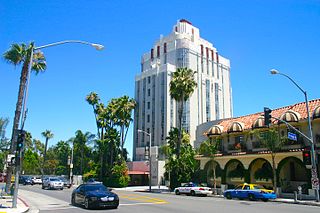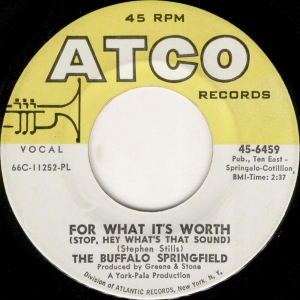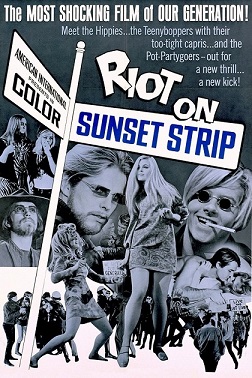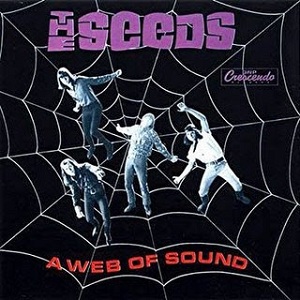
A hippie, also spelled hippy, especially in British English, is someone associated with the counterculture of the 1960s, originally a youth movement that began in the United States during or around 1964 and spread to different countries around the world. The word hippie came from hipster and was used to describe beatniks who moved into New York City's Greenwich Village, San Francisco's Haight-Ashbury district, and Chicago's Old Town community. The term hippie was used in print by San Francisco writer Michael Fallon, helping popularize use of the term in the media, although the tag was seen elsewhere earlier.

Buffalo Springfield was a rock band formed in Los Angeles by Canadian musicians Neil Young, Bruce Palmer and Dewey Martin and American musicians Stephen Stills and Richie Furay. The group, widely known for the song "For What It's Worth", released three albums and several singles from 1966 to 1968. Their music combined elements of folk music and country music with influences from the British Invasion and psychedelic rock. Like contemporary band the Byrds, they were key to the early development of folk rock. The band took their name from a steamroller parked outside their house.

The Sunset Strip is the 1.7-mile (2.7 km) stretch of Sunset Boulevard that passes through the city of West Hollywood, California, United States. It extends from West Hollywood's eastern border with the city of Los Angeles near Marmont Lane to its western border with Beverly Hills at Phyllis Street. The Sunset Strip is known for its boutiques, restaurants, rock clubs, and nightclubs, as well as its array of huge, colorful billboards.

The Whisky a Go Go is a historic nightclub in West Hollywood, California, United States. It is located at 8901 Sunset Boulevard on the Sunset Strip, corner North Clark Street, opposite North San Vicente Boulevard, northwest corner. The club has been the host for musicians and bands including Taj Mahal, Otis Redding, Hugh Masekela, Alice Cooper, The Doors,The Ramones, The Byrds, Three Dog Night, The Mothers of Invention, Buffalo Springfield, Led Zeppelin, The Kinks, Love, The Stooges, Parliament-Funkadelic, Metallica, Cheap Trick, Guns N' Roses, System of a Down, The Flying Burrito Brothers, Chicago, Germs, Elton John, Mötley Crüe, Steppenwolf, Van Halen, Rush, Johnny Rivers, X, Iron Butterfly, Shark Island, Fleetwood Mac, KISS, No Doubt, Death, AC/DC, Golden Earring, Linkin Park, Nirvana, The Beach Boys, Stryper, Norma Jean, Oasis, Everclear and Phil Seymour.

The Standells are an American garage rock band from Los Angeles, California, formed in the 1960s, who have been referred to as a "punk band of the 1960s", and said to have inspired such groups as the Sex Pistols and Ramones. They recorded the 1966 hit "Dirty Water", written by their producer, Ed Cobb. "Dirty Water" is the anthem of several Boston sports teams and is played following every Boston Red Sox and Boston Bruins home win.

The Chocolate Watchband is an American garage rock band that formed in 1965 in Los Altos, California. The band went through several lineup changes during its existence. Combining psychedelic and garage rock components, their sound was marked by David Aguilar's lead vocals, songwriting, as well as proto-punk musical arrangements. The band's rebellious musical posture made them one of the harder-edged groups of the period with many critics labeling them as America's answer to the Rolling Stones.

"For What It's Worth " is a song written by Stephen Stills. Performed by Buffalo Springfield, it was recorded on December 5, 1966, released as a single on Atco Records in December 1966 and peaked at No. 7 on the Billboard Hot 100 chart in the spring of 1967.

Riot on Sunset Strip is a 1967 counterculture-era exploitation movie, released by American International Pictures. It was filmed and released within four months of the late-1966 Sunset Strip curfew riots.

Ernest Eugene Debs was an American politician. He was a California State Assembly member from 1942 to 1947, a Los Angeles city councilman from 1947 to 1958 and a member of the Los Angeles County Board of Supervisors from 1958 to 1974.
"Daily Nightly" is a song by Michael Nesmith of the Monkees, which appeared on their fourth album, Pisces, Aquarius, Capricorn & Jones Ltd., in 1967, and was featured in two second-season episodes of their television series, "A Fairy Tale" and "Monkees Blow Their Minds".

Gazzarri's was a nightclub on the Sunset Strip in West Hollywood, California. The venue was a staple of the Los Angeles music scene from the 1960s until the early 1990s. The Doors and Van Halen were featured house bands there before being signed to major record labels. It was the backdrop for Huey Lewis and the News' short form promotional music video for their 1984 hit The Heart of Rock and Roll.

The Acid Tests were a series of parties held by author Ken Kesey primarily in the San Francisco Bay Area during the mid-1960s, centered on the use of and advocacy for the psychedelic drug LSD, commonly known as "acid". LSD was not made illegal in California until October 6, 1966.
The hippie subculture began its development as a youth movement in the United States during the early 1960s and then developed around the world.
Highs in the Mid-Sixties were a series of compilation albums released in the mid 1980s on AIP Records developed by Greg Shaw. The series was spun off of the similar Pebbles series. Each volume focuses on a specific geographical region.

A Web of Sound is the second album by the American garage rock band the Seeds. Produced by Marcus Tybalt and released in October 1966, it contained the single "Mr. Farmer" and the 14-minute closing song "Up In Her Room". The album did not chart, though it has received generally favorable reviews from music critics.

"Electricity" is a song by Captain Beefheart and his Magic Band on the 1967 album Safe as Milk. Beefheart claimed the label he and his band were signed to, A&M Records, dropped them after co-owner Jerry Moss heard the song and declared it "too negative" for his teenage daughter to listen to. Beefheart's vocals, while recording the final version for the album, shattered the microphone.

Pandora's Box was a nightclub and coffeehouse on the Sunset Strip in West Hollywood, California. It was at the center of the Sunset Strip curfew riots in 1966.

Edward Hoh was an American rock drummer who was active in the 1960s. Although primarily a studio session and touring drummer, Hoh exhibited a degree of originality and showmanship that set him apart and several of his contributions have been singled out for acknowledgment by music critics.

The Sloths are an American garage rock band formed in Los Angeles, California, in 1964. Although short-lived, the band had a profound presence on the Sunset Strip's live scene, and their lone single, "Makin' Love", while not very commercially successful during its original release, has been heavily praised since its inclusion on the Back from the Grave series. The Sloths, after their re-discovery by music historians, are now considered to be one of the "great lost garage bands", and surviving band members have been conducting reunion tours since 2012.

Inside Pop: The Rock Revolution is a 1967 American television documentary by David Oppenheim about young pop and rock musicians producing music as "a symptom and generator" of social unrest and generation gaps. Hosted by Leonard Bernstein, it was commissioned by CBS and broadcast on April 25, 1967. Musicians who appeared in the documentary included singer-songwriter Janis Ian, who performed her song "Society's Child", and Beach Boys leader Brian Wilson, who performed his song "Surf's Up".

















